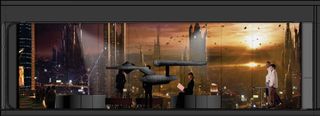Frankenstein to Star Trek: Sci-Fi Museum Coming to D.C.

Fans of Captain Kirk and Captain Nemo unite: A new science-fiction museum is coming to Washington, D.C.
Its creators announced plans for the museum, which will cover a broad sampling of science fiction across literature, television, film, music, video games and art, on Nov. 4. They hope to open a preview space within a year, and launch the full museum in the beginning of 2017.
"There really wasn't a comprehensive science-fiction museum here in the United States or internationally," said Greg Viggiano, executive director of the new venture. "I thought, maybe somebody should do something about this," Viggiano told LiveScience.
The museum will showcase seven distinct galleries, featuring the creators, vehicles, time travel concepts, aliens, computers, robots and technology. The content will start with Frankenstein author Mary Shelley, considered by many the first sci-fi author, and run through to present-day material. "We're going to try to cover sci-fi in a pretty comprehensive manner," Viggiano said. [Science Fact or Fantasy? 20 Imaginary Worlds]
Several collectors have already offered to loan their materials to the museum. These include models of the Enterprise E used in "Star Trek: Insurrection," and Amargosa Observatory and Deep Space 9 in earlier "Star Trek" films. Another collector has offered to loan their collection of "Battlestar Galactica" filming miniatures.
The museum has forged a partnership to store hundreds of interviews with sci-fi greats, from Ray Bradbury to Arthur C. Clarke.
As for Viggiano himself, he likes the classics — Jules Verne's "Twenty Thousand Leagues Under the Sea" (and the Disney version), and "Return to the Forbidden Planet," so expect those to make an appearance.
Sign up for the Live Science daily newsletter now
Get the world’s most fascinating discoveries delivered straight to your inbox.
The group has received significant interest already, Viggiano said. "The volunteer response has been overwhelming," and includes people with professional museum experience, he said.
The museum will be funded by private donors and through a crowd-funding campaign on the website IndieGoGo.com. The group had raised $23,914 on the site as of Nov. 19, and hopes to raise $160,000 by Dec. 11.
A big part of the museum's mission is to boost STEM (science technology engineering and mathematics) education, Viggiano said. Many of the exhibits will be interactive, geared toward both kids and kids-at-heart.
Follow Tanya Lewis on Twitter and Google+. Follow us @livescience, Facebook & Google+. Original article on LiveScience.

Most Popular


